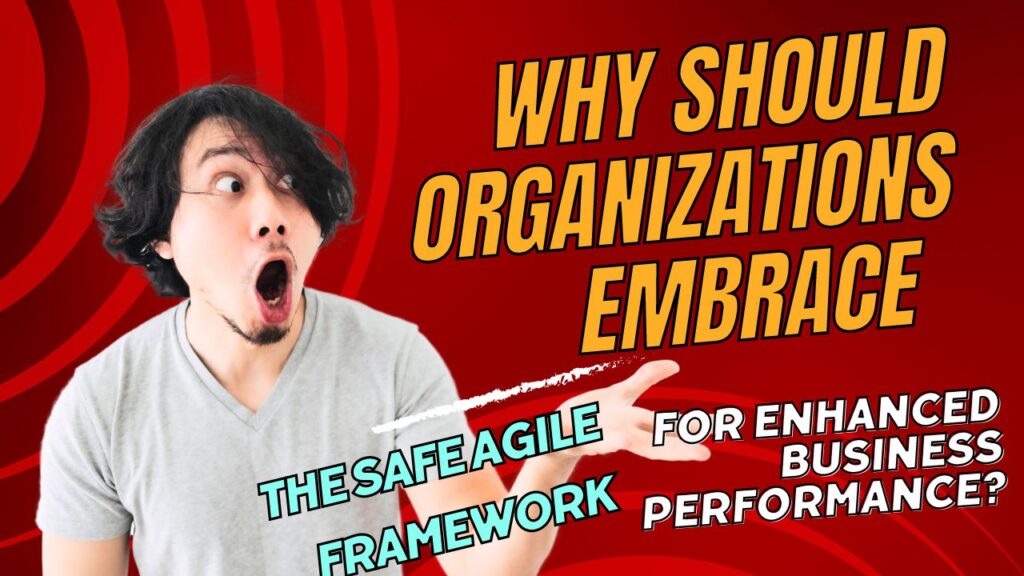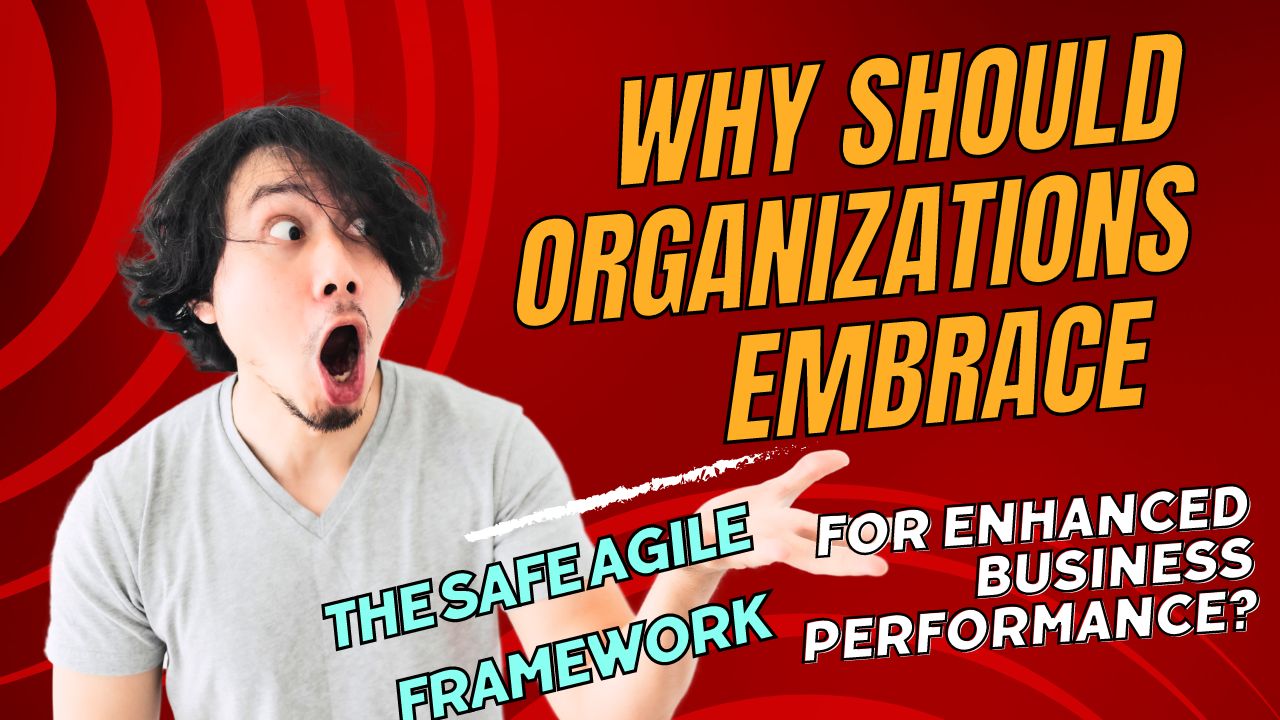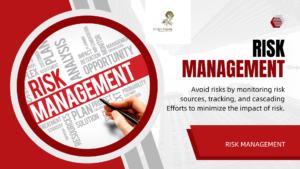Table of Contents
I. Introduction to SAFe Agile Framework

A. Definition of SAFe Agile
SAFe Agile, or the Scaled Agile Framework, is a comprehensive framework designed to enable organizations to scale Agile and Lean practices across the enterprise. Unlike traditional Agile methodologies that primarily focus on small teams, SAFe extends Agile principles to larger, more complex organizations. It provides a structured approach to implementing Agile at scale, allowing organizations to achieve greater flexibility, collaboration, and alignment across multiple teams and departments.
Example: Imagine a large software development company that has multiple teams working on interconnected projects. Without a framework like SAFe, coordinating the efforts of these teams and ensuring alignment with organizational goals can be challenging. SAFe provides a set of principles, practices, and roles that help organizations streamline their Agile implementation and achieve better outcomes at scale.
B. Brief History and Evolution of SAFe
SAFe was first introduced by Dean Leffingwell in 2011 as a response to the growing need for Agile practices to scale beyond individual teams. Over the years, SAFe has undergone several iterations and updates to address the evolving needs of the industry and incorporate feedback from practitioners worldwide. Today, SAFe is widely recognized as one of the leading frameworks for scaling Agile in large enterprises across various industries.
Example: In the early days of SAFe, it primarily focused on software development and IT organizations. However, as more companies outside the tech industry began adopting Agile practices, SAFe evolved to accommodate different business domains, including finance, healthcare, and manufacturing. This evolution reflects SAFe’s adaptability and its ability to cater to the diverse needs of modern enterprises.
C. Why SAFe Agile is Gaining Popularity
SAFe Agile is gaining popularity among organizations seeking to improve their agility, responsiveness, and ability to innovate in today’s fast-paced business environment. There are several reasons why SAFe has become the framework of choice for scaling Agile across the enterprise:
- Comprehensive Framework: SAFe provides a comprehensive set of practices, roles, and guidelines for scaling Agile, making it easier for organizations to adopt Agile at scale without reinventing the wheel.
- Alignment with Business Goals: SAFe emphasizes alignment between Agile teams and organizational goals, ensuring that Agile practices contribute to overall business success.
- Flexibility and Adaptability: SAFe is designed to be flexible and adaptable, allowing organizations to tailor Agile practices to their unique context and requirements.
- Improved Collaboration: By breaking down silos and fostering collaboration across teams and departments, SAFe encourages a culture of transparency, communication, and shared responsibility.
- Better Quality and Faster Time-to-Market: By adopting Agile practices at scale, organizations can deliver higher-quality products and services more quickly, leading to increased customer satisfaction and competitive advantage.
Example: A large financial institution decides to adopt SAFe Agile to modernize its software development processes and improve time-to-market for new products and features. By implementing SAFe, the organization is able to break down silos between development, testing, and operations teams, leading to faster feedback cycles, reduced lead times, and ultimately, a more competitive position in the market.
In conclusion, SAFe Agile offers a structured and scalable approach to implementing Agile practices across the enterprise, helping organizations achieve greater agility, collaboration, and business results.
II. Understanding the Core Principles of SAFe Agile
A. Overview of Agile Manifesto and Its Relevance to SAFe
The Agile Manifesto, crafted in 2001 by a group of software developers, outlines four key values and twelve principles that prioritize individuals and interactions over processes and tools, working software over comprehensive documentation, customer collaboration over contract negotiation, and responding to change over following a plan. SAFe builds upon the principles of the Agile Manifesto, adapting them to the needs of large-scale enterprises.
Example: Consider a software development team following the Agile Manifesto’s principle of “responding to change over following a plan.” In an Agile environment, the team welcomes changes in requirements, customer feedback, and market conditions, adjusting their plans and priorities accordingly. SAFe extends this principle by providing guidance on how to manage change at scale, ensuring alignment across multiple teams and stakeholders.
B. Key Principles of SAFe Agile
- Lean-Agile Mindset
The Lean-Agile mindset is foundational to SAFe, emphasizing a culture of continuous improvement, customer focus, and waste elimination. It encourages organizations to adopt Lean principles, such as value stream mapping, flow, and pull, to optimize processes and deliver value to customers more efficiently.
Example: A manufacturing company embraces the Lean-Agile mindset by implementing practices such as Kanban boards, Just-In-Time delivery, and continuous integration to streamline their production processes. By eliminating waste and optimizing workflow, the company is able to respond to customer demands more quickly and efficiently.
- Embracing Uncertainty and Change
SAFe recognizes that uncertainty and change are inherent in complex systems and environments. Instead of resisting change, SAFe encourages organizations to embrace uncertainty and adapt to changing conditions by fostering a culture of flexibility, resilience, and experimentation.
Example: A technology startup operating in a rapidly evolving market understands the importance of embracing uncertainty and change. Instead of rigidly adhering to a fixed plan, the startup adopts an Agile mindset, continuously iterating on its products based on customer feedback and market dynamics. This flexibility allows the startup to stay ahead of the competition and seize new opportunities as they arise.
- Delivering Value Continuously
SAFe emphasizes the importance of delivering value to customers continuously and iteratively. By breaking down work into small, manageable increments and delivering value incrementally, organizations can validate assumptions, gather feedback, and make course corrections more effectively.
Example: An e-commerce company adopts SAFe Agile practices to accelerate the delivery of new features and improvements to its online platform. Instead of waiting for months to release a large, monolithic update, the company delivers small, frequent updates to its website and mobile app, allowing it to respond to customer needs and market trends in real-time.
- Empowering Teams and Fostering Collaboration
SAFe encourages organizations to empower cross-functional teams and foster collaboration among team members, stakeholders, and customers. By decentralizing decision-making and promoting autonomy, organizations can unleash the creativity, expertise, and passion of their teams, leading to better outcomes and higher levels of engagement.
Example: A software development team adopts SAFe Agile practices such as Scrum and Kanban to improve collaboration and communication. Instead of working in isolation, team members collaborate closely with each other, sharing knowledge, ideas, and best practices. This collaborative approach leads to faster problem-solving, higher-quality deliverables, and greater satisfaction among team members.
In summary, understanding the core principles of SAFe Agile is essential for organizations looking to scale Agile practices effectively. By embracing a Lean-Agile mindset, embracing uncertainty and change, delivering value continuously, and empowering teams, organizations can create a culture of agility, innovation, and excellence.
III. Components of the SAFe Agile Framework
A. SAFe Agile at the Team Level
- Agile Teams and Agile Release Trains (ARTs)Agile teams are the foundational units of SAFe Agile, consisting of cross-functional members who work collaboratively to deliver value to customers. These teams follow Agile principles and practices, such as Scrum or Kanban, to iteratively develop and deliver working software. Agile Release Trains (ARTs) are collections of Agile teams aligned to a common mission or product. ARTs enable large-scale Agile development by providing a cadence for planning, synchronization, and delivery.Example: Imagine a software development company that adopts SAFe Agile. Within the organization, several Agile teams are responsible for developing different modules of a software product. These teams collaborate within an ART, which serves as a virtual organization focused on delivering value to customers. By aligning teams within an ART, the organization ensures coherence and alignment across multiple teams working on interconnected components of the product.
- Roles and Responsibilities Within Agile TeamsSAFe Agile defines specific roles and responsibilities within Agile teams to ensure clarity and accountability. These roles include:
- Product Owner: Represents the voice of the customer and defines the product vision and priorities.Scrum Master: Facilitates Agile ceremonies, removes impediments, and coaches the team on Agile practices.Development Team: Cross-functional group responsible for delivering potentially shippable increments of product functionality.
- Iterative Development and Incremental DeliverySAFe Agile promotes iterative development and incremental delivery to accelerate value realization and mitigate risks. Agile teams work in short iterations, typically 1-2 weeks long, to deliver small, incremental improvements to the product. Each iteration results in a potentially shippable increment of product functionality, allowing for frequent feedback and adaptation.Example: A software development team following SAFe Agile principles divides the development process into short iterations called sprints. During each sprint, the team selects a set of user stories from the product backlog and commits to delivering them by the end of the sprint. At the end of each sprint, the team conducts a sprint review with stakeholders to gather feedback on the delivered features and adjusts the product backlog accordingly.
B. SAFe Agile at the Program Level
- Program Increment (PI) Planning Program Increment (PI) planning is a key event in SAFe Agile where Agile Release Trains (ARTs) synchronize their efforts and plan for the upcoming iteration. PI planning typically occurs every 8-12 weeks and involves all members of the ART, including Agile teams, stakeholders, and system architects. During PI planning, teams review the program backlog, identify dependencies, and establish objectives and commitments for the upcoming increment.Example: In a SAFe Agile environment, a PI planning event brings together multiple Agile teams working on different components of a software product. During PI planning, teams collaborate to prioritize features and allocate work for the upcoming iteration. System architects provide guidance on technical dependencies and help resolve architectural issues. By aligning efforts during PI planning, teams ensure that they are working towards common objectives and delivering value to customers.
- ART Coordination and Synchronization Agile Release Trains (ARTs) require coordination and synchronization to ensure that multiple teams can work together effectively towards a shared goal. SAFe Agile provides mechanisms for ARTs to synchronize their work, including daily stand-ups, cross-team retrospectives, and system demos. Additionally, dedicated roles such as Release Train Engineer (RTE) help facilitate communication and alignment across teams.Example: In a SAFe Agile organization, an Agile Release Train (ART) consists of several Agile teams working on different features of a software product. The Release Train Engineer (RTE) facilitates daily stand-ups and ensures that teams are aligned with the overall program objectives. Additionally, cross-team retrospectives provide an opportunity for teams to reflect on their performance and identify areas for improvement. By synchronizing their efforts, teams can maximize productivity and deliver value to customers more efficiently.
- PI Execution and Inspect and Adapt Events Program Increment (PI) execution involves the implementation and delivery of features by Agile teams within the Agile Release Train (ART). Throughout the PI, teams collaborate closely, conduct regular stand-ups, and address any impediments that arise. At the end of the PI, SAFe Agile encourages inspect and adapt events, where teams reflect on their performance, gather feedback, and identify opportunities for improvement.Example: During a Program Increment (PI), Agile teams within an ART work collaboratively to develop and deliver features according to the PI objectives. Daily stand-ups provide an opportunity for teams to synchronize their efforts, discuss progress, and address any issues or dependencies. At the end of the PI, teams participate in an inspect and adapt event, where they review their performance, gather feedback from stakeholders, and identify actions to improve their processes for the next PI.
C. SAFe Agile at the Portfolio Level
- Portfolio Vision and Strategy Alignment SAFe Agile encourages alignment between the portfolio vision and organizational strategy to ensure that Agile initiatives support broader business objectives. Portfolio visioning involves defining a clear and compelling vision for the portfolio, articulating the desired outcomes and value propositions. Strategic themes and investment themes help guide portfolio decisions and ensure that investments align with strategic priorities.Example: In a SAFe Agile organization, portfolio visioning involves senior leadership defining the overarching goals and objectives for the portfolio. This vision serves as a guiding light for portfolio decision-making, helping stakeholders prioritize initiatives and allocate resources effectively. By aligning portfolio initiatives with organizational strategy, the organization can ensure that Agile investments contribute to long-term business success.
- Lean Portfolio Management Lean Portfolio Management (LPM) is a set of principles and practices that help organizations govern and prioritize portfolio investments in a Lean and Agile manner. LPM focuses on maximizing the flow of value through the portfolio, optimizing the allocation of resources, and ensuring that investments are aligned with strategic objectives. Key LPM activities include strategy and investment funding, portfolio Kanban, and Lean governance.Example: In a SAFe Agile organization, Lean Portfolio Management (LPM) provides a framework for governing and prioritizing portfolio investments. Portfolio Kanban boards visualize the flow of portfolio initiatives from ideation to implementation, allowing stakeholders to track progress and identify bottlenecks. Lean governance mechanisms, such as regular portfolio reviews and decision-making forums, ensure that investments align with strategic goals and deliver maximum value to the organization.
- Investment Funding and Budgeting SAFe Agile promotes Lean and Agile approaches to investment funding and budgeting, enabling organizations to allocate resources dynamically based on value and risk. Lean Budgets replace traditional annual budgeting cycles with more flexible funding mechanisms, such as rolling-wave budgeting and incremental funding. Funding decisions are guided by Lean-Agile principles, strategic themes, and economic frameworks, such as Lean business cases and Cost of Delay.Example: In a SAFe Agile organization, investment funding and budgeting are guided by Lean-Agile principles and economic frameworks. Rather than relying on fixed annual budgets, funding decisions are made dynamically based on the value and risk associated with portfolio initiatives. Rolling-wave budgeting allows organizations to adapt their budgets in response to changing market conditions and emerging opportunities. By adopting Lean approaches to funding and budgeting, organizations can maximize the return on investment and optimize the allocation of resources to high-value initiatives
IV. Implementing SAFe Agile
A. Steps for SAFe Agile Transformation
- Assessing Organizational Readiness Before embarking on a SAFe Agile transformation journey, organizations need to assess their readiness for Agile at scale. This involves evaluating factors such as leadership support, organizational culture, existing processes, and technical capabilities. Conducting a thorough assessment helps identify strengths, weaknesses, and areas of improvement, laying the groundwork for a successful transformation.Example: A large manufacturing company considering a SAFe Agile transformation begins by assessing its current state of Agile maturity. The assessment reveals that while Agile practices are well-established at the team level, there is limited alignment with strategic goals and coordination between teams. Recognizing the need for a more scaled approach, the organization decides to pursue SAFe Agile to address these challenges.
- Creating a Lean-Agile Center of Excellence (LACE)Establishing a Lean-Agile Center of Excellence (LACE) is crucial for driving and sustaining SAFe Agile transformation. LACE serves as a dedicated team responsible for guiding the transformation, providing coaching and training, and fostering a culture of continuous improvement. LACE members typically include Agile coaches, Scrum Masters, and Lean-Agile leaders who have expertise in SAFe Agile principles and practices.Example: The manufacturing company appoints a group of experienced Agile coaches and Scrum Masters to form the Lean-Agile Center of Excellence (LACE). The LACE team collaborates with senior leadership to define the vision and roadmap for the SAFe Agile transformation. They develop training programs, conduct workshops, and provide ongoing support to Agile teams and leaders throughout the transformation journey.
- Training and Coaching Teams and LeadersTraining and coaching are essential components of a successful SAFe Agile transformation. Organizations need to invest in educating teams and leaders about Agile principles, SAFe practices, and new roles and responsibilities. Training programs should be tailored to the specific needs of different groups within the organization, including Agile teams, Product Owners, Scrum Masters, and executives.Example: The manufacturing company implements a comprehensive training program to equip teams and leaders with the knowledge and skills needed for SAFe Agile. Agile coaches conduct workshops on topics such as SAFe fundamentals, Agile ceremonies, and Lean-Agile leadership. They provide hands-on coaching and mentorship to help teams apply Agile practices effectively in their day-to-day work.
B. Overcoming Common Challenges in SAFe Agile Implementation
- Resistance to Change Resistance to change is a common challenge encountered during SAFe Agile implementations, especially in organizations with entrenched traditional processes and hierarchical structures. Overcoming resistance requires effective communication, stakeholder engagement, and leadership support. Organizations need to emphasize the benefits of Agile at scale, address concerns, and involve employees in the transformation process.Example: During the SAFe Agile transformation, some employees express skepticism about adopting new Agile practices and fear the uncertainty of change. To address this resistance, the manufacturing company conducts town hall meetings, leadership forums, and interactive workshops to communicate the vision and rationale behind the transformation. They involve employees in decision-making processes and create opportunities for feedback and dialogue to build buy-in and ownership.
- Scaling Agile Beyond Software Development Scaling Agile beyond software development presents challenges related to organizational complexity, cross-functional collaboration, and alignment with business objectives. Organizations need to adapt Agile practices to different business functions, such as marketing, finance, and operations, and ensure that Agile principles are applied consistently across the enterprise. This requires a shift in mindset, culture, and processes to embrace Agile ways of working.Example: As the SAFe Agile transformation progresses, the manufacturing company expands Agile practices beyond software development to other business areas, such as product management and customer service. They establish cross-functional Agile teams to work on end-to-end value streams, breaking down silos and fostering collaboration across departments. By aligning Agile practices with business objectives, the organization achieves greater agility and responsiveness to customer needs.
- Cultural Barriers and Organizational Silos Cultural barriers and organizational silos can hinder collaboration, communication, and alignment in SAFe Agile implementations. Organizations need to promote a culture of transparency, trust, and empowerment, where employees feel safe to experiment, fail, and learn. Breaking down silos requires cross-functional collaboration, shared goals, and a focus on customer value to overcome departmental boundaries and foster a culture of collaboration.Example: The manufacturing company recognizes that cultural barriers and siloed mindsets pose challenges to the SAFe Agile transformation. They implement initiatives to promote collaboration, such as cross-functional workshops, team-building activities, and knowledge-sharing sessions. Leaders encourage open communication, celebrate success stories, and recognize individuals who demonstrate Agile values and behaviors. Over time, these efforts help break down silos and create a more collaborative and empowered workforce.
In conclusion, implementing SAFe Agile requires a structured approach, strong leadership support, and a commitment to continuous improvement. By following steps for transformation and addressing common challenges, organizations can successfully scale Agile practices across the enterprise and realize the benefits of increased agility, collaboration, and innovation.
V. SAFe Agile in Practice: Real-World Examples and Case Studies
A. Case Study 1: SAFe Agile Transformation in a Large Enterprise
Case Overview:
Company XYZ, a multinational corporation operating in the technology sector, embarked on a SAFe Agile transformation to enhance agility, improve time-to-market, and foster innovation across its diverse business units. With thousands of employees spread across different locations worldwide, the organization faced challenges related to siloed operations, slow decision-making processes, and limited collaboration between departments.
Implementation Approach:
The SAFe Agile transformation at Company XYZ began with a comprehensive assessment of organizational readiness, identifying key areas for improvement and establishing a roadmap for change. The organization formed a Lean-Agile Center of Excellence (LACE) comprising Agile coaches, Scrum Masters, and Lean-Agile leaders to spearhead the transformation efforts. Training and coaching programs were rolled out to educate teams and leaders about Agile principles, SAFe practices, and new roles and responsibilities.
Results and Impact:
Over the course of the SAFe Agile transformation, Company XYZ witnessed significant improvements in its ability to deliver value to customers more rapidly and responsively. Agile Release Trains (ARTs) were established to align cross-functional teams working on related products or initiatives, facilitating collaboration and coordination across the organization. Program Increment (PI) planning events became focal points for synchronizing efforts, setting objectives, and fostering cross-team alignment.
Lessons Learned:
- Executive sponsorship and leadership commitment are critical drivers of successful SAFe Agile transformations, providing direction, support, and resources for change.
- Effective communication and stakeholder engagement are essential to build buy-in, address resistance, and create a shared vision for Agile transformation.
- Continuous improvement and adaptation are key principles of Agile, requiring organizations to embrace change, experiment, and learn from both successes and failures.
B. Case Study 2: SAFe Agile Adoption in a Regulated Industry
Case Overview:
Company ABC, a leading provider of healthcare solutions, embarked on a SAFe Agile adoption journey to modernize its software development practices, enhance product quality, and ensure compliance with regulatory requirements. Operating in a highly regulated industry characterized by stringent quality standards and complex approval processes, the organization faced unique challenges in implementing Agile practices while maintaining regulatory compliance.
Implementation Approach:
The SAFe Agile adoption at Company ABC began with a thorough assessment of regulatory constraints, identifying areas where Agile practices could be applied while ensuring adherence to regulatory requirements. The organization established cross-functional Agile teams consisting of software engineers, quality assurance specialists, and regulatory experts to collaborate on product development. Lean portfolio management principles were applied to prioritize initiatives and allocate resources based on risk and value.
Results and Impact:
Despite the regulatory constraints, Company ABC achieved significant improvements in its software development processes and product quality through SAFe Agile adoption. By embracing Agile practices such as iterative development, continuous integration, and test automation, the organization was able to deliver high-quality products more rapidly while maintaining compliance with regulatory standards. Lean portfolio management principles enabled the organization to prioritize initiatives based on business value and regulatory impact.
Lessons Learned:
- Balancing Agile principles with regulatory requirements requires a nuanced approach, involving collaboration between Agile teams, regulatory experts, and compliance officers.
- Implementing Agile practices such as test automation, continuous integration, and incremental delivery can improve software quality and accelerate time-to-market while ensuring compliance with regulatory standards.
- Lean portfolio management principles enable organizations to prioritize initiatives based on risk, value, and regulatory impact, ensuring alignment with business objectives and compliance requirements.
C. Lessons Learned and Best Practices from Successful SAFe Agile Implementations
- Executive sponsorship and leadership support are critical for driving SAFe Agile transformations, providing vision, direction, and resources for change.
- Tailoring Agile practices to suit the unique context and constraints of the organization, such as regulatory requirements, industry standards, and organizational culture, is essential for success.
- Continuous learning, adaptation, and improvement are fundamental principles of Agile, requiring organizations to embrace change, experiment, and iterate based on feedback and results.
In conclusion, real-world case studies provide valuable insights into the implementation and impact of SAFe Agile in diverse organizational contexts. By learning from successful implementations and applying lessons learned and best practices, organizations can navigate their Agile transformation journeys effectively and realize the benefits of increased agility, collaboration, and innovation.
VI. Future Trends and Developments in SAFe Agile
A. Emerging Trends in Agile and Lean Practices
With the rapid evolution of technology and business landscapes, Agile and Lean practices continue to evolve to meet the changing needs and challenges of organizations. Some emerging trends in Agile and Lean practices include:
- Lean Product Development: Organizations are increasingly adopting Lean principles to optimize their product development processes, reduce waste, and accelerate time-to-market. Lean Product Development emphasizes customer-centricity, value stream mapping, and continuous improvement to deliver high-quality products and services efficiently.
- Agile at Scale: As organizations scale Agile practices beyond individual teams to entire enterprises, there is a growing focus on frameworks such as SAFe (Scaled Agile Framework) to facilitate large-scale Agile transformations. Agile at Scale enables organizations to align multiple Agile teams, coordinate efforts, and deliver value more effectively across complex value streams.
- DevOps Integration: The integration of Agile and DevOps practices is gaining traction as organizations seek to streamline the end-to-end software delivery lifecycle. DevOps emphasizes collaboration, automation, and continuous delivery, complementing Agile principles and enabling faster, more reliable software releases.
B. The Impact of Digital Transformation on SAFe Agile
Digital transformation is reshaping industries and driving organizations to adopt Agile practices to stay competitive in today’s digital economy. The impact of digital transformation on SAFe Agile includes:
- Increased Demand for Agility: Digital disruption and changing customer expectations are driving organizations to become more agile and responsive to market changes. SAFe Agile provides a framework for organizations to adapt quickly, innovate, and deliver value to customers in a rapidly evolving digital landscape.
- Emphasis on Customer Experience: Digital transformation places a greater emphasis on delivering exceptional customer experiences across digital channels. SAFe Agile enables organizations to prioritize customer-centricity, iterate on feedback, and deliver value-driven solutions that meet customer needs and expectations.
- Agile Governance and Compliance: Digital transformation introduces new challenges related to governance, compliance, and risk management. SAFe Agile provides governance mechanisms, such as Lean portfolio management and Agile Release Trains, to ensure alignment with strategic objectives, regulatory requirements, and risk mitigation strategies.
C. Continuous Evolution of the SAFe Framework
The SAFe framework continues to evolve to address emerging trends, feedback from practitioners, and changes in the industry landscape. Some areas of continuous evolution in the SAFe framework include:
- Enhanced Flexibility: SAFe is continually adapting to accommodate diverse organizational contexts, industry verticals, and Agile maturity levels. The framework offers configurable guidance and toolkits to tailor practices to specific needs and enable organizations to scale Agile effectively.
- Integration with Emerging Technologies: SAFe is incorporating principles and practices to support the adoption of emerging technologies such as artificial intelligence, machine learning, and blockchain. These technologies enable organizations to innovate, optimize processes, and deliver value more efficiently in the digital age.
- Community Collaboration: SAFe’s evolution is driven by a vibrant community of practitioners, coaches, and thought leaders who contribute insights, best practices, and case studies. The SAFe community fosters collaboration, knowledge sharing, and continuous learning, ensuring that the framework remains relevant and effective in addressing real-world challenges.
In conclusion, the future of SAFe Agile is shaped by emerging trends in Agile and Lean practices, the impact of digital transformation on organizational agility, and the continuous evolution of the SAFe framework to meet the evolving needs of organizations in the digital age. By staying abreast of these trends and developments, organizations can effectively navigate their Agile transformation journeys and realize the benefits of increased agility, innovation, and business success.
VII. Conclusion
A. Recap of Key Points Covered in the Guide
Throughout this guide, we explored the SAFe Agile framework in depth, covering its core principles, components, implementation steps, real-world case studies, future trends, and continuous evolution. We discussed the importance of understanding Agile and Lean practices, the impact of digital transformation on organizational agility, and the role of SAFe Agile in driving business success.
B. Importance of Adopting SAFe Agile for Organizational Agility and Business Success
Adopting SAFe Agile is crucial for organizations looking to thrive in today’s dynamic and competitive business environment. By embracing Agile principles and practices at scale, organizations can achieve greater agility, responsiveness, and innovation, enabling them to deliver value to customers more rapidly and effectively. SAFe Agile provides a structured framework for scaling Agile practices across the enterprise, aligning teams, processes, and objectives to drive business success.
C. Final Thoughts and Recommendations for Readers Embarking on Their SAFe Agile Journey
As readers embark on their SAFe Agile journey, it is essential to approach the transformation with a clear vision, strong leadership support, and a commitment to continuous learning and improvement. Here are some final thoughts and recommendations to guide readers on their SAFe Agile journey:
- Start with a thorough assessment of organizational readiness and alignment with Agile principles and values.
- Establish a Lean-Agile Center of Excellence (LACE) to guide the transformation and provide coaching and support to teams and leaders.
- Invest in training and education to ensure that teams and leaders have the necessary skills and knowledge to succeed in the SAFe Agile environment.
- Foster a culture of collaboration, experimentation, and continuous improvement, where teams are empowered to innovate and adapt to change.
- Embrace feedback and iteration, and be willing to adjust strategies and approaches based on lessons learned and evolving business needs.
- Celebrate successes, recognize achievements, and share best practices to inspire and motivate teams on their SAFe Agile journey.
By following these recommendations and embracing the principles of SAFe Agile, organizations can navigate their transformation journey effectively and realize the full potential of Agile at scale.
In conclusion, adopting SAFe Agile is not just a methodology; it’s a mindset shift that enables organizations to thrive in an increasingly complex and uncertain world. By embracing agility, collaboration, and innovation, organizations can position themselves for long-term success and create value for their customers, employees, and stakeholders alike.



